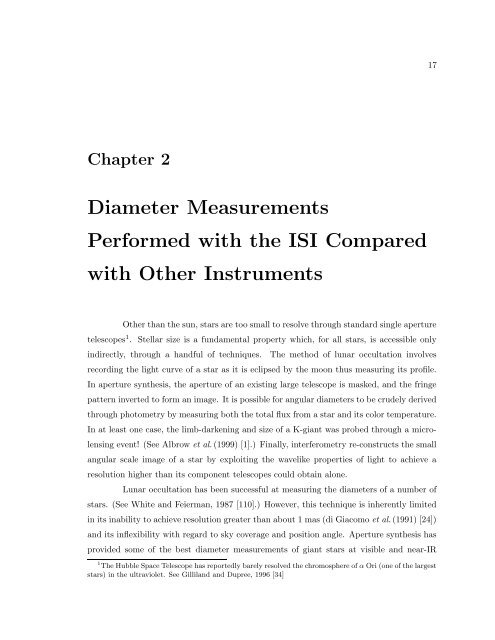The Size, Structure, and Variability of Late-Type Stars Measured ...
The Size, Structure, and Variability of Late-Type Stars Measured ...
The Size, Structure, and Variability of Late-Type Stars Measured ...
You also want an ePaper? Increase the reach of your titles
YUMPU automatically turns print PDFs into web optimized ePapers that Google loves.
17<br />
Chapter 2<br />
Diameter Measurements<br />
Performed with the ISI Compared<br />
with Other Instruments<br />
Other than the sun, stars are too small to resolve through st<strong>and</strong>ard single aperture<br />
telescopes 1 . Stellar size is a fundamental property which, for all stars, is accessible only<br />
indirectly, through a h<strong>and</strong>ful <strong>of</strong> techniques.<br />
<strong>The</strong> method <strong>of</strong> lunar occultation involves<br />
recording the light curve <strong>of</strong> a star as it is eclipsed by the moon thus measuring its pr<strong>of</strong>ile.<br />
In aperture synthesis, the aperture <strong>of</strong> an existing large telescope is masked, <strong>and</strong> the fringe<br />
pattern inverted to form an image. It is possible for angular diameters to be crudely derived<br />
through photometry by measuring both the total flux from a star <strong>and</strong> its color temperature.<br />
In at least one case, the limb-darkening <strong>and</strong> size <strong>of</strong> a K-giant was probed through a microlensing<br />
event! (See Albrow et al. (1999) [1].) Finally, interferometry re-constructs the small<br />
angular scale image <strong>of</strong> a star by exploiting the wavelike properties <strong>of</strong> light to achieve a<br />
resolution higher than its component telescopes could obtain alone.<br />
Lunar occultation has been successful at measuring the diameters <strong>of</strong> a number <strong>of</strong><br />
stars. (See White <strong>and</strong> Feierman, 1987 [110].) However, this technique is inherently limited<br />
in its inability to achieve resolution greater than about 1 mas (di Giacomo et al. (1991) [24])<br />
<strong>and</strong> its inflexibility with regard to sky coverage <strong>and</strong> position angle. Aperture synthesis has<br />
provided some <strong>of</strong> the best diameter measurements <strong>of</strong> giant stars at visible <strong>and</strong> near-IR<br />
1 <strong>The</strong> Hubble Space Telescope has reportedly barely resolved the chromosphere <strong>of</strong> α Ori (one <strong>of</strong> the largest<br />
stars) in the ultraviolet. See Gillil<strong>and</strong> <strong>and</strong> Dupree, 1996 [34]













![Problem #1 [Structure Formation I: Radiation Era]](https://img.yumpu.com/37147371/1/190x245/problem-1-structure-formation-i-radiation-era.jpg?quality=85)


